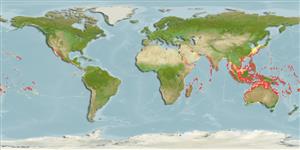Common names from other countries
Classification / Names / Names
ماع يماسا | فدارتم | Catalog of Fishes (gen., sp.) | ITIS | CoL | WoRMS
Environment: milieu / climate zone / depth range / distribution range
يسانش موب
; قمع تارييغت 0 - 100 m (Ref. 348), usually 0 - 5 m (Ref. 348). Tropical
Indo-Pacific: from East Africa, to eastern Polynesia; north to Japan and south to Queensland and New Caledonia.
Length at first maturity / Size / Weight / نس
Maturity: Lm ? range ? - ? cm Max length : 11.0 cm SHL يسنج صاوخ نودب / رن سنج; (Ref. 348); common length : 8.5 cm يسنج صاوخ نودب / رن سنج; (Ref. 348)
Maximum depth from Ref. 101147. Attached by its byssus to coral slabs, rubble under the slab (Ref. 101147), under coral heads and rocks (Ref. 348). Frequently encrusted by sponges, bryozoans, algae, and other marine growths. Able to swim actively for some distance when detached. Common in the intertidal and shallow subtidal zones (Ref. 348). Also occurs on rubble, soft sediments, and scattered reefs (Ref. 87907). At night, adults seem to move to open water to feed and return to rubble pile in the day (Ref. 101147).
Life cycle and mating behavior
غولب | لثم دیلوت | یزیر مخت | اه مخت | Fecundity | )ورال ( دازوت
Members of the class Bivalvia are mostly gonochoric, some are protandric hermaphrodites. Life cycle: Embryos develop into free-swimming trocophore larvae, succeeded by the bivalve veliger, resembling a miniature clam.
یلصا ذخآم
عجارم | هدننك گنهامه | ناراكمه
Poutiers, J.M. 1998. (Ref. 348)
NCUI زمرق تسرهف رد تيعضو (Ref. 130435)
ستياس رظن زا تيعضو (Ref. 108899)
Not Evaluated
Not Evaluated
اه ناسنا یارب رطخ
Harmless
یناسنا هدافتسا
| FishSource |
اهرازبا
رتشيب تاعالطا
Age/Size
دشر
نزو - لوط
لوط - لوط
يسانش تخير
)ورال ( دازوت
يناوارف
يتنرتنيا عبانم
Estimates based on models
Preferred temperature
(Ref.
115969): 24.6 - 29.2, mean 28.3 (based on 3624 cells).
یريذپ بيسآ
Low vulnerability (10 of 100).
